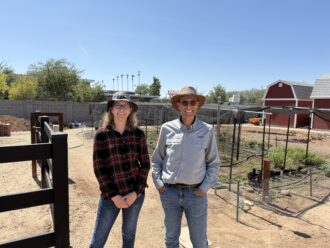When supply chains collapsed and grocery shelves sat empty in the first years of the COVID pandemic, many people got interested in growing their own food.
Most of those didn’t have access to dozens or hundreds of acres of land. What land they could find were small urban plots, or suburban backyards, or maybe a full acre or two at a local incubator farm or co-op.
“These are folks who were interested in food security and producing food for their community and they quickly realized that agriculture is not easy,” explained entomologist Ayman Mostafa, the director of the Center for Urban Smart Agriculture at the University of Arizona. The Center launched in 2022 to serve these new urban farmers throughout the state of Arizona and build that sector of the state’s agricultural economy.
“These new farmers struggled with pest management, and we got a lot of questions about that,” Mostafa said. “The overall concepts of sustainable pest management are applicable to both large and small farms, but the strategies vary. Our goal is not just to make the practices sustainable, but to make the knowledge sustainable as well within the community.”
To that end, the Center for Urban Smart Agriculture began a new series of pest management workshops this week, using a train-the-trainer approach to develop greater expertise in different Arizona communities.
“The first one will be really to gauge the interests and needs of the participants,” explained Naomi Pier, the program manager of the Center. “We want to develop this collaboratively with them from start to end.”
Funded with an 18-month grant from the Western Sustainable Agriculture Research and Education program, the quarterly workshop series will cover all the pests plaguing small-scale growers in Arizona and help develop a curriculum and resources to train future generations of farmers.
And the university experts will be learning along with the farmers because both, interestingly, are in the same stage of development.
“The people that started during the pandemic and are still producing are beyond the beginning-farmer stage and are now running profitable businesses,” Mostafa said. “Their systems are more complex and their needs and questions are more sophisticated.”
Some of those growers are supplying local restaurants and hotels. Some are selling in Sprouts and Whole Foods supermarkets. Some have developed cooperative cold-storage facilities and divide the production of different crops between them to maximize and share their combined profits, and others sell to local food banks and at farmers’ markets. Many produce value-added products. These are established, profitable businesses.
“There’s one couple who grow produce for their own cafe, then compost the food scraps to fertilize their farm,” Pier said. “It’s as near to a closed system at it can be, and each one of these growers could be pioneering something that could be developed widely in the future.”
But, at the moment, the science is a step behind.
“They need crop-specific information for their scale of production in this specific climate, but most of the knowledge that’s been developed is for large-scale agriculture,” Mostafa explained. “We have pest thresholds for cotton and alfalfa for example, but those aren’t applicable to a quarter-acre field. There’s never been that kind of research for this scale of agriculture in Arizona’s climate.”
And the environmental aspect of the equation is critical. Pest management research has been done for urban farms in other regions, but lessons from the cool Pacific Northwest or humid Northeast simply don’t apply to the desert Southwest.
“We can give good recommendations,” Mostafa said, “but they’re just not as solid scientifically as I want as an entomologist.”
So new research is under way and mutual learning between Arizona’s professional urban growers and professional agricultural scientists will continue, developing the knowledge they both need to see the urban ag sector grow and prosper. One goal of Mostafa’s is a proof-of-concept plot to show that a quarter-acre of land can produce $100,000 of annual agricultural income.
He believes that’s the future.
“Arizona lost 62 percent of its farmland between 2017 and 2022 and still produces the same amount of food or more,” he said. “Urban agriculture is a phenomenon. It’s a movement, and we’re here to support it.”
Learn more about the Center for Urban Smart Agriculture.
